TAFLIR is the abbreviation for the "Tactical Flight Radar" of the Swiss Air Force. TAFLIR is used to improve the Recognized Air Picture and to support air traffic control and air surveillance of the Swiss Air Force.
Contents

TAFLIR is the abbreviation for the "Tactical Flight Radar" of the Swiss Air Force. TAFLIR is used to improve the Recognized Air Picture and to support air traffic control and air surveillance of the Swiss Air Force.

The topography of Switzerland is such that certain areas and even radar shadows do not allow surveillance by permanently installed radars placed on mountains. In 1985, five mobile radar systems were purchased for 254 million Swiss francs in order to address this problem. [1] Switzerland procured the mobile radars to improve the nation's aerial warfare capability. However, the system's viability in a military operation was a controversial matter that was brought to attention and addressed in the initial attack waves of the Iraq War.

TAFLIR is a version of the AN/TPS-70 radar produced by Westinghouse (now Northrop Grumman), modified for Swiss requirements. It replaced the Target Allocation Radar TPS-1E. These AN/MPQ-64 radars are a variant of the Northrop Grumman AN/TPS-75 and can be deployed in areas of difficult terrain to improve the Recognized Air Picture. Peacetime TAFLIR deployment locations are at Dübendorf and Payerne. In times of crisis or war they can be deployed anywhere. [2]
They employ a phased array antenna, which reduces the appearance of side lobes by more than 50%, thus reducing vulnerability to anti-radar missiles and a secondary radar. The radar uses a phase-encoded pulse compression to improve accuracy and resolution at a distance. As an active protection measure against electronic countermeasures the frequency can be changed to pulse. The heart of the TAFLIR system is the rotating antenna mounted on a truck. Containers hold further components such as radar electronics, terminal operation and cooling equipment. The modular TAFLIR system allows vehicles can be exchanged and the TAFLIR may relocate within hours. Radar data of the TAFLIR are fed directly to the FLORAKO system.
In times of peace, the system is stationed near military airfields to improve the Recognized Air Picture. Any systems not in use are stored in particular electromagnetic pulse-protected caverns. The TAFLIR system can operate in any location accessible by truck and can be deployed within a few hours.
TAFLIR is deployed to support security during annual World Economic Forum meetings in Davos, Switzerland. A mobile radar LW company is required to operate a TAFLIR system. All the mobile companies belong to Air Force Radar Battalion 2. [3]
The Austrian Tiefflieger Acquisition Radar (TER) is a comparable system.
TAFLIR deployment locations are at Dübendorf and Payerne. In times of crisis or war they can be redeployed elsewhere. [4]

Northrop Grumman Corporation is an American global aerospace and defense technology company. With over 85,000 employees and an annual revenue in excess of $30 billion, it is one of the world's largest weapons manufacturers and military technology providers. The firm ranks No. 108 on the 2020 Fortune 500 list of America's largest corporations.

An active electronically scanned array (AESA) is a type of phased array antenna, which is a computer-controlled array antenna in which the beam of radio waves can be electronically steered to point in different directions without moving the antenna. In the AESA, each antenna element is connected to a small solid-state transmit/receive module (TRM) under the control of a computer, which performs the functions of a transmitter and/or receiver for the antenna. This contrasts with a passive electronically scanned array (PESA), in which all the antenna elements are connected to a single transmitter and/or receiver through phase shifters under the control of the computer. AESA's main use is in radar, and these are known as active phased array radar (APAR).

The Swiss Air Force is the air component of the Swiss Armed Forces, established on 31 July 1914 as part of the army and in October 1936 as an independent service.
Northrop Grumman Electronic Systems (NGES) was a sector until a reorganization on 2016-01-01 merged NGES and other businesses into a new Mission Systems sector. NGES had originally been created by Northrop Grumman's acquisition of Westinghouse Electronic Systems Group in 1996. The Electronic Systems sector was a leading designer, developer, and manufacturer of a wide variety of advanced defense electronics and systems. The division had 120 locations worldwide, including 72 international offices, and approximately 24,000 employees. Accounting for 20% of company sales in 2005, it was the single largest sector in the corporation.

The AN/APG-68 radar is a long range Pulse-doppler radar designed by Westinghouse to replace AN/APG-66 radar in the F-16 Fighting Falcon. The AN/APG-68(V)8 and earlier radar system consists of the following line-replaceable units:
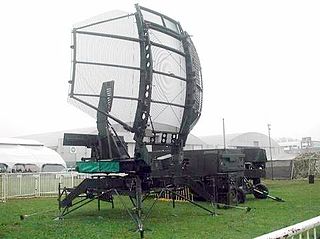
The AN/TPS-43 is a transportable air search 3D radar produced in the United States originally by Westinghouse Defense and Electronic Division, which was later purchased by Northrop-Grumman.
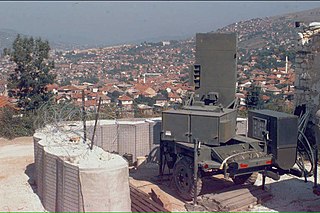
Hughes AN/TPQ-36 Firefinder Weapon Locating System is a mobile radar system developed in the mid-late 1970s by Hughes Aircraft Company and manufactured by Northrop Grumman and ThalesRaytheonSystems, achieving Initial Operational Capability in May, 1982. The system is a "weapon-locating radar", designed to detect and track incoming mortar, artillery and rocket fire to determine the point of origin for counterbattery fire. It is currently in service at battalion and higher levels in the United States Army, United States Marine Corps and Australian Army. Also Turkish Army, Portugal and Ukrainian Army are among the users.

A passive electronically scanned array (PESA), also known as passive phased array, is an antenna in which the beam of radio waves can be electronically steered to point in different directions, in which all the antenna elements are connected to a single transmitter and/or receiver. The largest use of phased arrays is in radars. Most phased array radars in the world are PESA. The civilian microwave landing system uses PESA transmit-only arrays.

The AN/TPS-75 is a transportable passive electronically scanned array air search 3D radar produced in the United States. It was originally designated the TPS-43E2. Although the antenna is a radically new design from the TPS-43, the radar van itself, which houses the transmitter, receiver processors, and displays is very similar to the older TPS-43E2. It is produced in the United States originally by Westinghouse Defense and Electronic Division, which was later purchased by Northrop-Grumman.
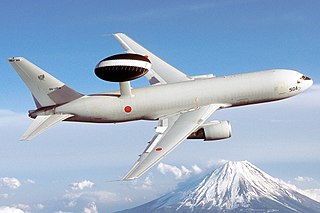
The Boeing E-767 is an Airborne Warning and Control System (AWACS) aircraft. It was designed in response to the Japan Air Self-Defense Force's requirements, and is essentially the Boeing E-3 Sentry's surveillance radar and air control system installed on a Boeing 767-200.
The Northrop Grumman AN/ZPY-1 STARLite Small Tactical Radar - Lightweight is a small, lightweight synthetic aperture radar/GMTI radar used in tactical operations. The radar is under contract to the U.S. Army Communications and Electronics Command for its ERMP General Atomics MQ-1C Gray Eagle Unmanned Aerial System and is manufactured by Northrop Grumman. STARLite weighs 65 lb (29 kg)., occupies 1.2 cubic feet (34 L), and requires less than 750W of power. The Army began to take delivery of the system in 2010. Also in 2010 the system was ready for deployment to the battlefield.

The AN/TPS-80 Ground/Air Task Oriented Radar (G/ATOR) is the United States Marine Corps next generation Air Surveillance/Air Defense and Air Traffic Control (ATC) Radar. The mobile active electronically scanned array radar system is currently being developed by Northrop Grumman and was expected to reach initial operating capability in August 2016.

FLORAKO is a Swiss radar system for military and civil aviation. The acronym stands for FLORIDA radar replacement air radar system capable communication system in the initial phase of the project meant the name FLORES RALUS KOMSYS and emerged from the project name of the sub-systems. There are four surface to air missile tubes located on the site.

The Target allocation radar TPS-1E is an omnidirectional pulse radar device. It was used from 1958 until 1989 by the Swiss Air Force. It was also used by German army (Heer) air defence reconnaissance platoons up until the early 1990s.
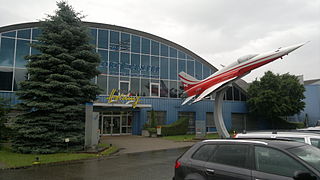
The Flieger Flab Museum is located in the Canton of Zurich in Dübendorf on the grounds of Dübendorf Air Base. In the museum, 40 airplanes and helicopters are displayed, with the collection divided into distinct eras: pioneers and World War I, the 1930s, World War II and the postwar period, the beginning of the jet age, the development of jet fighters, the Cold War, and arms reduction.
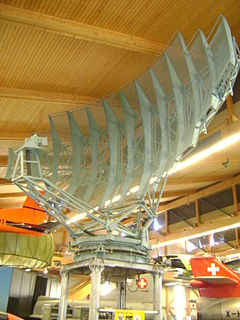
The SFR Airspace monitoring and management system was the first Airspace monitoring and management system of the Swiss Air Force.
The AN/TPS-44 is a transportable 2-dimensional air search radar produced in the United States originally by Cardion Electronics.

The Fliegerstaffel 24 fighter squadron 24 of the Swiss Air Force was a former standalone squadron, which is now the ECM (German:EKF) part of the Zielflugstaffel 12. It is a militia squadron and belongs to the airfield command 7. Its home base is the Militärflugplatz Emmen. The Fliegerstaffel 24 carries as coat of arms an eagle in front of a light blue background, holding a lightning bolt in the right claw, in the background is a red-orange number 24 and above the coat of arms is a red-orange area with the black writing "Fliegerstaffel".

AN/TPS-70 is a mobile S band phased array 3D radar produced by Westinghouse. It can track 500 targets, displaying target range, height, azimuth, Identification Friend/Foe (IFF) information from an altitude of 0 to 100,000 feet to a maximum range of 240 nautical miles. It is the successor of AN/TPS-43. The TPS-70 tactical radar provides reliability, sensitivity, and accuracy, even in the face of jamming and high-clutter conditions.